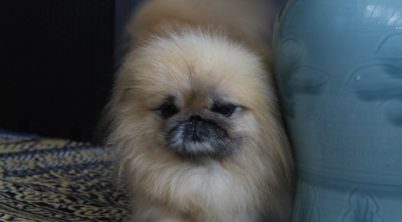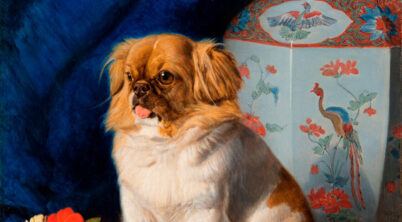Pekingese dogs are known for their long, luxurious double coats that exude elegance and grandeur but also come with a significant shedding factor. The breed typically sheds throughout the year, with seasonal peaks usually tied to changes in weather. Owners should expect the natural shedding process to occur, as it is a healthy and normal part of a Pekingese’s life cycle. It’s important to manage these shedding levels through regular grooming to maintain the coat’s health and appearance, and to keep loose hairs under control.
The Pekingese’s coat consists of a thick undercoat and a longer outer coat, which together provide insulation and protection. This double layering means that shedding can be quite noticeable, with a higher volume of hair loss compared to breeds with less dense coat types. Regular brushing and combing are essential to prevent the coat from tangling and matting, an issue that not only affects aesthetics but can lead to skin irritation and discomfort for the dog. Moreover, grooming sessions help distribute natural skin oils throughout the coat, promoting a healthy shine and reducing skin dryness, which can further minimize excessive shedding.
Understanding the dynamics of Pekingese shedding is crucial for potential owners who may be sensitive to pet dander or who prefer a tidy living environment. Being prepared for the grooming needs of a Pekingese—including the tools and time commitment required—is an integral part of responsible ownership. While managing shedding may seem daunting, it also provides an opportunity for bonding between the owner and their Pekingese, ensuring that the dog remains a well-kept and cherished companion.
Table of Contents
Understanding Pekingese Shedding
Pekingese dogs have a distinct double coat that goes through a natural shedding cycle. This process is influenced by various factors that owners should be aware of to manage shedding effectively.
Shedding Cycle
The Pekingese possesses a double coat that consists of a thick, soft undercoat and a long, straight outer coat. The shedding cycle of the Pekingese involves the regular loss of old or damaged hair. Typically, seasonal shedding occurs—often more pronounced during the change of seasons as they prepare for warmer or cooler weather.
Factors Affecting Shedding
Several factors can affect the rate and amount of shedding in a Pekingese:
- Genetics: The breed inherently tends to shed.
- Season: They may experience heavier shedding in spring and fall.
- Health and Nutrition: Poor nutrition or health issues can lead to excessive shedding.
- Grooming: Adequate grooming reduces shedding by removing loose hairs from the undercoat.
Regular brushing, as often as 2-3 times per week, is vital in managing the Pekingese’s shedding. It helps in removing debris and preventing mats and tangles that can exacerbate shedding issues.
Grooming Techniques to Manage Shedding
Effective grooming techniques are integral to managing a Pekingese’s shedding. By incorporating regular brushing and proper bathing practices, owners can significantly reduce the amount of hair shed and keep their Pekingese’s coat healthy and vibrant.
Brushing Essentials
For Pekingese owners, regular grooming and brushing are pivotal in managing shedding. Utilizing a slicker brush can effectively remove loose hair and prevent mats. It’s recommended to brush their coat at least three times a week, if not daily during peak shedding seasons.
- Tools for Brushing:
- Slicker Brush: Removes tangles and loose fur.
- Comb: Fine-toothed combs can help detail around the face and feet.
- Deshedding Tool: Can reach deeper into the double coat to remove dead undercoat.
Following a consistent brush routine will keep the coat free of tangles, reduce shedding, and maintain the Pekingese’s iconic appearance.
Bathing Best Practices
Bathing of a Pekingese should be performed with care, using a dog-specific shampoo that supports coat health. Bathing too frequently can strip the coat of natural oils, so it’s generally advised to bathe a Pekingese every 2 to 3 months or as needed. However, during peak shedding periods, a slightly increased bathing schedule can help loosen the undercoat and remove shed fur.
- Steps for Bathing:
- Gently brush the coat before wetting to detangle and remove loose fur.
- Use lukewarm water to wet the coat thoroughly.
- Apply dog-specific shampoo and massage it into the coat, avoiding the eyes and ears.
- Rinse completely, ensuring no residue remains.
- Dry the coat with a towel or a low-heat blow dryer, and brush gently during the drying process to assist in removing shed hair.
By adhering to these bathing guidelines, one can support their Pekingese’s coat during shedding periods and enhance the efficacy of their grooming routine.
Diet and Nutrition for a Healthy Coat
A Pekingese’s coat health is greatly influenced by its diet, which should be rich in proteins, essential fatty acids, and specific nutrients to mitigate excessive shedding. It is essential for owners to understand the relationship between what their Pekingese eats and the condition of its coat.
Food Allergies and Sensitivities
Common Signs of Allergies:
- Itching
- Poor coat quality
When Pekingese exhibit symptoms like itching and poor coat quality, food allergies or sensitivities could be the cause. A hypoallergenic diet, avoiding common allergens like beef, dairy, and wheat, may provide relief. It is crucial to identify the specific allergen through an elimination diet, progressively removing potential triggers and monitoring the dog’s response.
Supplements for Skin and Coat Health
Key Supplements:
- Omega-3 Fatty Acids
- Omega-6 Fatty Acids
In addition to a balanced diet, supplements can enhance coat health. Omega-3 and Omega-6 fatty acids are vital for maintaining a shiny, healthy coat. They can be found in:
| Source | Fatty Acid Type |
|---|---|
| Fish oil | Omega-3 |
| Flaxseed oil | Omega-3 |
| Evening primrose oil | Omega-6 |
| Sunflower oil | Omega-6 |
Inclusion of high-quality proteins in the diet supports hair growth and repair. For Pekingese experiencing shedding due to nutritional deficiencies, incorporating these supplements may reduce shedding and improve coat condition. It is important for owners to consult with a veterinarian before adding any supplements to their Pekingese’s diet to ensure they are addressing specific health issues and nutritional requirements appropriately.
Health and Shedding: Identifying Underlying Issues
Shedding in Pekingese can often be a normal process; however, it can also be indicative of health concerns that require attention. Recognizing the difference is key to ensuring the well-being of these dogs.
Common Pekingese Health Concerns
Pekingese can be prone to several health issues that contribute to excessive shedding. Hypothyroidism is a condition where the thyroid gland is underactive and can lead to a variety of symptoms including poor coat quality and hair loss. Skin infections, often marked by signs such as redness, itching, and scabbing, can also cause increased shedding and are not uncommon in this breed. Additionally, internal stressors, such as those from hormonal imbalances or allergies, often manifest through the skin and coat condition of a Pekingese.
- Hypothyroidism: Hair loss, dry skin, weight gain
- Skin infections: Itching, redness, hair loss
- Stress: Changes in environment or routine leading to shedding
When to Consult a Veterinarian
Owners should monitor their Pekingese closely for signs of abnormal shedding that might be symptomatic of underlying health conditions. If shedding appears excessive or is accompanied by other symptoms such as skin irritation, lethargy, or changes in appetite, it is advisable to consult a veterinarian. They are equipped to diagnose health issues, potentially including hypothyroidism or infections, through a series of tests and examinations. Early detection and treatment are crucial for managing health concerns and thus, reducing undue shedding.
- Signs prompting veterinary visit:
- Excessive shedding not related to seasonality
- Skin irritation or infection symptoms
- Behavioral changes indicating stress or discomfort
Lifestyle Adjustments to Reduce Shedding
In managing a Pekingese’s shedding, incorporating regular exercise and stress reduction into their lifestyle is essential. These adjustments contribute significantly to maintaining a healthy coat and can lessen shedding intensity.
Exercise and Weight Management
Regular exercise is crucial for a Pekingese’s overall health, directly impacting their coat’s condition. A consistent routine helps prevent obesity, a condition that can exacerbate shedding due to underlying stress on the skin. Experts suggest daily walks or play sessions tailored to the Pekingese’s size and stamina to maintain optimal weight.
- Daily Exercise: 15-30 minutes of walking or play
- Weight Check: Regular vet visits for weight assessments
Stress Reduction Techniques
Stress and anxiety can lead to increased shedding in Pekingese dogs. It is important to create a calm environment for them to minimize stress-related hair loss. Implementing a predictable routine can offer stability, while designated quiet areas in the home, away from noisy or high-traffic parts, provide a safe space for relaxation.
- Routine: Consistency in feeding, exercise, and sleep schedule
- Safe Spaces: Comfortable beds or crates in quieter areas of the home
Providing toys and occasional mental stimulation through games or puzzles can also help reduce anxiety, which in turn may alleviate excessive shedding.








